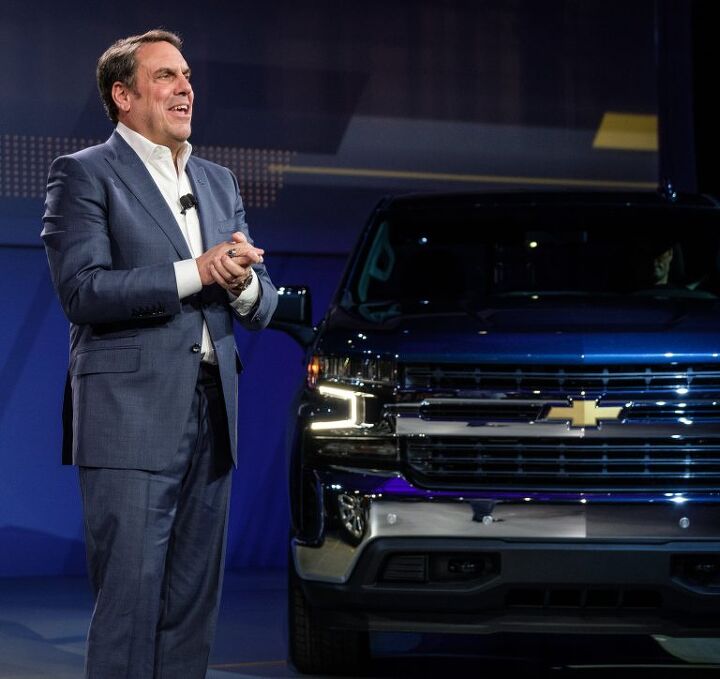Executive Shuffle: GM's Reuss Straddles the Globe As EV Boss Tackles Product

A number of General Motors executives will have to update their CVs come November 1st. As it moves to position its increasingly streamlined business for hard-fought future growth, the automaker has provided President Mark Reuss with a number of new hats.
Doug Parks, head of GM’s autonomous and electric vehicle programs since 2016, will soon find himself in charge of global product development.
“I am thrilled to be able to hand over the keys to our Global Product Development, Purchasing and Supply chain team to someone as talented and dedicated as Doug, who has been instrumental in leading the development of our electric and autonomous vehicle programs,” Reuss said in a statement. “He has an outstanding team in place that will keep this company moving forward.”
The career upgrade sees Perks join the automaker’s senior leadership team. Filling Park’s castoff shoes is Ken Morris, vice president of Global Product Programs, who’ll see his old job filled by Tim Herrick, executive chief engineer of GM’s full-size trucks.
Donning the title of president in January, Reuss’ responsibilities expand come November. He’ll be tasked with overseeing the company’s North America, South America, China and International regions.
“Our industry is transforming faster than at any time in its history,” said GM CEO Mary Barra in a statement. “Aligning our regional operations under Mark will drive even greater collaboration and speed-to-market, and accelerate growth opportunities in our core business and in the future of mobility.”
Elsewhere in the automaker’s executive suite, Steve Kiefer, senior vice president, Global Purchasing and Supply Chain, will take on the role of senior vice president and president for the company’s South American and international operations.
[Image: General Motors]

More by Steph Willems
Latest Car Reviews
Read moreLatest Product Reviews
Read moreRecent Comments
- Kjhkjlhkjhkljh kljhjkhjklhkjh A prelude is a bad idea. There is already Acura with all the weird sport trims. This will not make back it's R&D money.
- Analoggrotto I don't see a red car here, how blazing stupid are you people?
- Redapple2 Love the wheels
- Redapple2 Good luck to them. They used to make great cars. 510. 240Z, Sentra SE-R. Maxima. Frontier.
- Joe65688619 Under Ghosn they went through the same short-term bottom-line thinking that GM did in the 80s/90s, and they have not recovered say, to their heyday in the 50s and 60s in terms of market share and innovation. Poor design decisions (a CVT in their front-wheel drive "4-Door Sports Car", model overlap in a poorly performing segment (they never needed the Altima AND the Maxima...what they needed was one vehicle with different drivetrain, including hybrid, to compete with the Accord/Camry, and decontenting their vehicles: My 2012 QX56 (I know, not a Nissan, but the same holds for the Armada) had power rear windows in the cargo area that could vent, a glass hatch on the back door that could be opened separate from the whole liftgate (in such a tall vehicle, kinda essential if you have it in a garage and want to load the trunk without having to open the garage door to make room for the lift gate), a nice driver's side folding armrest, and a few other quality-of-life details absent from my 2018 QX80. In a competitive market this attention to detai is can be the differentiator that sell cars. Now they are caught in the middle of the market, competing more with Hyundai and Kia and selling discounted vehicles near the same price points, but losing money on them. They invested also invested a lot in niche platforms. The Leaf was one of the first full EVs, but never really evolved. They misjudged the market - luxury EVs are selling, small budget models not so much. Variable compression engines offering little in terms of real-world power or tech, let a lot of complexity that is leading to higher failure rates. Aside from the Z and GT-R (low volume models), not much forced induction (whether your a fan or not, look at what Honda did with the CR-V and Acura RDX - same chassis, slap a turbo on it, make it nicer inside, and now you can sell it as a semi-premium brand with higher markup). That said, I do believe they retain the technical and engineering capability to do far better. About time management realized they need to make smarter investments and understand their markets better.


































Comments
Join the conversation
until they fix the marketing, nothing else matters and most of our work ends futile and frustrating. here's our new tailgate, buy one without and get $10,000. WTF?
What really bothers me about this move electric cars is not the change itself, as much as how it shows that the fundamental culture of GM survived the bankruptcy. That is - Here we go with another “Great Leap Forward”. GM has always and forever embraced new technologies and just jumped right in with both feet, and sadly, usually without enough testing and development before release to the public. The last successful great leap I remember is the Chevy V8 back in 1955 (although it may have had teething problems that had been forgotten and forgiven by the time I appeared on the scene). But since then, well: The Corvair. The Vega The Citation The Diesel Saturn The Fiero The 8-6-4 The Northstar All of these were -like the electric car program- headlong plunges. No gradual introductions and slow refinements for The General! Damn the [s]Toyota[/s] Torpedos! Full Speed Ahead! Again. Almost always later abbreviated to read, “ Damn Torpedos....”